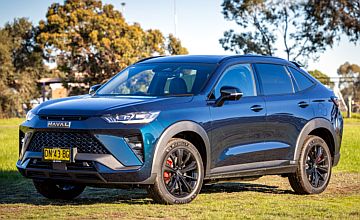Make / Model Search
OptionsCar reviews - GWM - Haval - H6 GT PHEVGWM modelsOverviewWe like Solid value for money against competitor set; commendable all-electric driving range; mostly cohesive powertrain calibration; respectable build quality inside and out Room for improvement Ride/handling balance needs work; ADAS calibration is off the mark; complex infotainment interface; some tyre thrum on coarse chip surfaces; no spare wheel The Haval H6 GT PHEV seems great on paper, but how does it stack up in the real world?2 Jul 2025 By MATT BROGAN Overview
PLUG-IN hybrid electric vehicles, or PHEVs for short, make a lot of sense as a mid-step to ‘going electric’.
In daily use, and with the means and discipline to charge the vehicle regularly, many modern PHEVs offer sufficient range for the weekday commute, while having plenty of petrol power in reserve for those times it’s needed.
As technology has improved, so has the reality of PHEV ownership. No longer do PHEVs travel just a handful of kays on electric charge alone – the GWM Haval H6 GT PHEV delivering a comfortable 100km or more before the petrol engine makes its presence known.
Sure, GWM claims you can travel up to 180km on electric power alone, but the NEDC test regime is rather optimistic. In real-world conditions, our result from the 35.4kWh battery was the best we could get.
Add this to the 55 litres of 91RON unleaded fuel for use by the petrol engine and it’s easy to achieve a driving range of close to 900km. Charging is offered via a CCS2 plug at up to 6.6kW on the AC frequency and 48kW on DC.
Of course, the PHEV variant is $10,000 more expensive than its petrol-powered counterpart, GWM asking $55,990 plus on-road costs for the model which arrives in just one, highly specified trim grade.
That price tag sees it compete fairly alongside rivals like the BYD Sealion 6 Premium AWD (from $52,990), Jaecoo J7 SHS Summit (from $47,990), or the ubiquitous Mitsubishi Outlander PHEV ES AWD (from $57,290).
Nineteen-inch alloy wheels (no spare wheel) are accompanied by a panoramic glass sunroof, LED lighting, privacy glass, a powered tailgate, dusk-sensing headlights and rain-sensing wipers, and keyless entry and ignition.
These highlights joined inside by combination suede and leather upholstery with heating and ventilation up front, powered seat adjustment, dual-zone climate control, ambient lighting, a wireless phone charging pad, head-up display, a 10.25-inch digital instrument panel, and an unfortunately complex 12.3-inch touchscreen infotainment array.
The infotainment system offers access to 360-degree camera technology, wired Apple CarPlay and Android Auto connectivity, AM/FM/DAB+ digital radio, various apps, and vehicle settings controlling sound, connectivity, ADAS settings, and more.
Elsewhere, the cabin offers a useful level of storage – the sliding console drawer-cum-cupholder a handy GWM feature – including additional storage on the console’s flanks with multiple USB-A outlets, useful door pockets, 60:40 split-fold rear seats, and 392 litres of boot space in five-seat configuration (or 1390 litres all told).
At the opposite end of the coupe-SUV we find a turbocharged 1.5-litre four-cylinder petrol engine paired with dual electric motors, a dedicated two-speed hybrid transmission, and all-wheel drive. Dishing up a claimed combined output of 321kW and 762Nm, the package is said to enable a 0-100km/h time just shy of five seconds (4.9s).
A brake-by-wire system provides stopping via all-wheel discs, while suspension duties are handled by a Macpherson strut arrangement at the front and multilink setup at the rear. Braked towing capacity is listed at 1500kg.
On the all-important safety front we find seven airbags (including a front-centre airbag), adaptive cruise control, autonomous emergency braking, blind-spot monitoring, driver fatigue monitoring, front and rear parking sensors, lane keeping assistance, rear cross-traffic alert, traffic sign recognition, tyre pressure monitoring, and more.
GWM backs the H6 GT PHEV with a seven-year/unlimited-kilometre warranty and eight-year/unlimited-kilometre high-voltage battery warranty. Roadside assistance is included for five years, as is capped-price servicing. Regular service intervals are pegged at 12 months / 15,000km (whichever comes first).
Driving Impressions
We are going to come right out and say that the Haval H6 GT PHEV does not feel as potent as its manufacturer’s claims might suggest. Simply, the 321kW/762Nm and 4.9 second 0-100km/h time does not translate in real-world conditions, the vehicle feeling brisk, but never truly fast.
The multiple drive modes – annoyingly accessed via the central touchscreen – offer an incremental shift in the way the car delivers its output and allow you to flick between all-electric and petrol-electric operation.
But simply, there is a lot of weight to move around (2075kg), and in our opinion it is that which takes the gloss of what otherwise might be a performance-oriented offering worthy of a ‘GT’ badge.
Obviously, that heft also makes its presence known in cornering. The suspension struggles to keep control of wheel movement, particularly over poorer road surfaces. Adaptive damping may have been useful here but is sorely lacking from the H6 GT kit list.
We found front-end understeer to arrive more quickly than expected, the too-stiff set-up relying heavily on the Michelin tyres to secure purchase.
It’s also evident that the firmer suspension tune erodes ride quality on patchy roads, while at the same time contributing to a level of tyre thrum. As handsome and spacious as the H6 GT cabin may look, it’s not the serenely comfortable space we had envisaged.
The H6 GT PHEV offers larger braking hardware than its derivate with brake-by-wire control enabling purposeful stopping power when required. Unfortunately, the pedal stroke is very short, meaning modulation over the level of braking required is somewhat lacking.
Equally bothersome is the human-machine interface (HMI) that requires the touchscreen for most interactions. There are fixed buttons for the demisters, hazard lights, and camera, but none for temperature control, drive modes, or ADAS and charging preferences.
The ‘Hey GWM’ voice control is an alternative here, but not a good one. We found the system laggy and easily confused; little wonder then so many OEMs are returning the use of hard buttons in their cars…
While the GWM Haval H6 GT PHEV offers solid value for money against its rivals, commendable all-electric driving range, and respectable build quality inside and out, we can’t help but feel the brusque ride/handling balance, complex HMI, and off-the-mark ADAS technologies are a letdown in this instance.
Add to that the lack of a spare wheel and a considerable level of tyre thrum on Aussie roads and the H6 GT PHEV becomes a vehicle we’d find hard to recommend. Perhaps the soon-to-arrive H6 update will provide the antidote GWM needs to make a good car excellent… we look forward to finding out.  Read more23rd of June 2025  GWM introduces Tank 500 Vanta to OzBlack-on-black styling features on the GWM Tank 500 Vanta, priced from $75,990 driveaway20th of June 2025  GWM extends Tank 300, Cannon service intervalsDiesel-powered Tank 300 and Cannon models now offer 12-month/15,000km service intervals22nd of May 2025  GWM incentivises Cannon Alpha PHEV buyersNational ABN and fleet price structure announced for Cannon Alpha PHEV until June 30All car reviews Alfa Romeo Alfa Romeo Abarth Abarth Audi Audi Aston Martin Aston Martin BMW BMW Bentley Bentley Chrysler Chrysler Chevrolet Chevrolet Dodge Dodge Citroen Citroen Ferrari Ferrari DS DS Ford Ford Fiat Fiat FPV FPV Foton Foton Haval Haval Great Wall Great Wall Honda Honda Holden Holden Hyundai Hyundai HSV HSV Isuzu Isuzu Infiniti Infiniti Jaguar Jaguar Iveco Iveco Kia Kia Jeep Jeep Land Rover Land Rover Lamborghini Lamborghini Maserati Maserati Lexus Lexus McLaren McLaren Mazda Mazda Mercedes-Benz Mercedes-Benz Mitsubishi Mitsubishi Mini Mini Opel Opel Nissan Nissan Porsche Porsche Peugeot Peugeot Ram Ram Proton Proton Rolls-Royce Rolls-Royce Renault Renault Skoda Skoda Saab Saab SsangYong SsangYong Smart Smart Suzuki Suzuki Subaru Subaru Toyota Toyota Tesla Tesla Volvo Volvo |
OptionsClick to share
|











Facebook Twitter Instagram